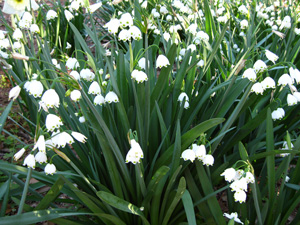Resource Library
Plant of the Week: Summer Snowflake
The University of Arkansas System Division of Agriculture does not promote, support or recommend plants featured in "Plant of the Week." Please consult your local Extension office for plants suitable for your region.
Plant of the Week
Summer Snowflake
Latin: Leucojum aestivum

Like being a middle child, some plants are easily overlooked in the headlong rush into the full flush of the growing season. Summer snowflake (Leucojum aestivum) is one of these late-season flowering bulbs that is pretty and tough but comes along late enough in the spring bulb season to be easily missed.
Summer snowflake is a bulbous plant of the amaryllis family, and as such shares many characteristics with daffodils (foliage, bulb structure and size) and snowdrops (Galanthus – flower color and floral anatomy). Bulbs are similar in size and shape to daffodils, with the foliage emerging from them in early spring, and growing 12 to 14 inches long and half an inch wide. Like narcissus, snowflake foliage dies away by midsummer. It is considered one of the deer-proof plants because they won’t eat the foliage.
Blooms
Snowflake blooms appear in mid-to-late spring on 14 inch-long scapes that usually are gracefully listing at some acute angle from the vertical. Like all members of the amaryllis family, the blooms are enclosed in a single sheath that encases five to seven dangling white bells with six equal-sized segments, each of which is tipped by a spot of green. Individual flowers have a pendant pedicel that terminates in a small green ovary from which protrudes the six tepals. The nodding flowers are about half an inch across.
In snowflakes (Galanthus), the white tepals are also green-tipped, but in this genus the three inner segments are much smaller in size than the three outer ones. The inferior ovary (petals affixed to the top of the ovary instead of the base) and the subtending sheath are two key diagnostic features that separate the amaryllis family from the closely related lily family.
Nomenclature
The Latin name for summer snowflake is a mish-mash of name confusion. The genus name Leucojum is from an old Greek name and translates as “white violet,” a name that Thomas Johnson used in the 1633 edition of Gerard’s famous herbal. There it is called “the many flowered great bulbous violet.” Linnaeus, when he brought order to plant naming a century later, confused things a bit when he used the epitaph “aestivum”, which in Latin means “summer blooming”. Summer snowflake is definitely spring-blooming, but it flowers about two weeks later than the other spring blooming snowflake, L. vernum.
Where did summer snowflake come from?
The summer snowflake is native over a wide swath of western and southern Europe, and extends into the Middle East in Turkey and Iran. It has been grown in European gardens since at least the 16th century. It never seems to have had a medicinal use, but was just grown for garden ornament. It was introduced during the first wave of European settlement to the New World and is now known in all of the eastern states, but especially south of the Mason Dixon Line. Many southern gardeners recount getting bulbs of this heirloom plant from old home sites, where their great-great ancestors had gotten it from their great-great ancestors. Because of its white flowers and because it blooms during the rush of spring bloom, it is often easy to overlook this spring charmer.
How do I care for summer snowflake?
Summer snowflake is a long-lived bulb that flourishes in moderate shade to full sun. It is not particular to soil type and thrives in heavy clay soils that would spell death to more timid bulbous species. It should be planted five inches deep, with the bulbs spaced about 6 inches apart. It will flower for five or more years without need of division, but eventually clumps will become too crowded to bloom well and will require lifting as the foliage begins to die down in early summer. The form offered in the nursery trade at the current time is ‘Gravetye Giant’, a large-flowered selection made by William Robinson in 1924 from material growing at Gravetye Manor in England.
By: Gerald Klingaman, retired
Retired Extension Horticulturist - Ornamentals
Extension News - March 16, 2012
The University of Arkansas System Division of Agriculture does not maintain lists of retail outlets where these plants can be purchased. Please check your local nursery or other retail outlets to ask about the availability of these plants for your growing area.